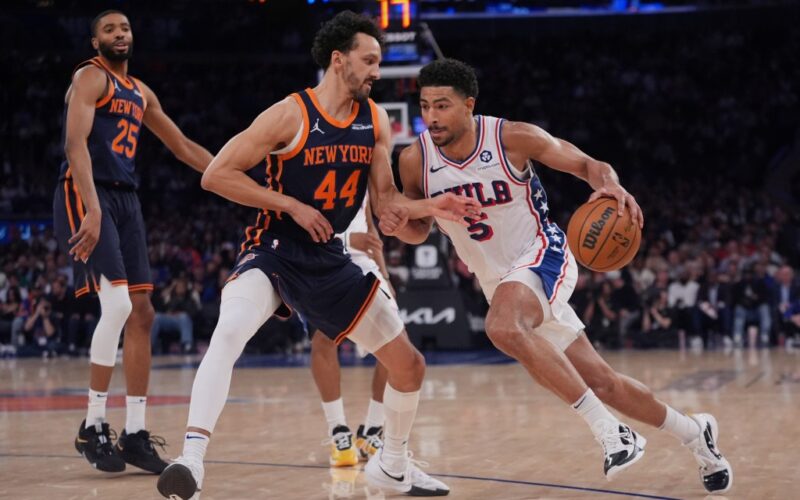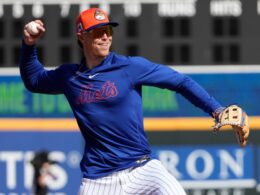Nick Nurse just wanted a body.
The Philadelphia 76ers were spiraling into the abyss, their championship hopes unraveling with each new addition to the injury report. Paul George didn’t hold up long. Neither did Joel Embiid. Suddenly, the Sixers had little to play for. A once-deep team had become a shell of itself, and when Dallas called offering Quentin Grimes and a second-round pick for veteran wing Caleb Martin shortly after shocking the world with the Luka Doncic trade to the Los Angeles Lakers, the decision made itself.
“Caleb just wasn’t healthy. He wasn’t playing,” Nurse, the 76ers’ head coach, says now. “Everybody knows what Caleb can do. But he just couldn’t stay on the court. So I was really excited [about the trade] because I thought, ‘We have a body,’ first and foremost.”
Grimes has been far more than just a body. Since arriving in Philadelphia, he’s not just been present — he’s been productive.
Nearly 27 points per game in March. Forty-four against Golden State. Forty-six in a loss to Houston. Twenty-six more Tuesday night at Madison Square Garden against the team that drafted him 25th overall in the 2021 NBA Draft.
Grimes is no longer a spare part in a crowded Knicks rotation. He’s a featured piece — one who’s suddenly putting up star numbers, even if those numbers are coming in losses.
The Sixers are 3-11 in Grimes’ March appearances. But the volume? The efficiency? The rhythm?
It’s real.
“He’s had great moments in the league,” says Tom Thibodeau, who coached Grimes through his first three-and-a-half seasons with the Knicks. “He’s playing, he’s got great rhythm. He can shoot it, put it on the floor, he’s dangerous in transition. He’s making good plays off the dribble. Defensively, he’s terrific. Very dangerous in the open floor.”
Now, as Grimes heads into restricted free agency this summer, the questions are loud — and they are justified.
Are these numbers a byproduct of volume on a losing team robbed of its star power? Or has Grimes always had this in him, hiding in plain sight beneath the role player’s uniform? Can a player who excels in a bad situation carry his production over when the expectation is to win?
“I think it’s a super valid question,” Nurse says. “And I think you have to know exactly what’s happening — and I think you have to figure out how that fits with what you possibly have. In our ideal world, he’s not getting these many attempts when we have our three main scorers playing.
“But I think the real world is those guys [Embiid, George and Tyrese Maxey] are in and out. So maybe can he be a guy who plays one role one night and steps up a role in certain situations, those kind of things. I think he can score the ball. I think he can shoot, which is what we need.”
* * *
Quentin Grimes flashes a knowing smile — part nostalgia, part satisfaction — as the memories rush back.
“I’m pretty comfortable in this arena,” he says, glancing around the visitor’s locker room. “I was here for three years.”
Those years were formative. And what once felt like frustration has, with time and distance, softened into appreciation for the environment — and the head coach — that molded him.
“Playing for Thibs, he gave me a great foundation on what the NBA is, how to be a pro, how to approach every game like it’s a Game 7,” says Grimes. “Thibs is super prepared every game, takes no B.S. and doesn’t take anything lightly, and never tries to overlook anything. So having that kind of got my mindset really geared to when I go into any game, I take it very seriously.”
What Grimes is doing now is impressive, but to understand how he got here — how a former role player turned into one of the league’s hottest scorers — you have to go back to where it started.
Thibodeau always saw this version of Grimes in flashes: gym-rat motor, high-volume 3-point shooting, defensive intensity. But on a team with one basketball to share between Jalen Brunson, Julius Randle, R.J. Barrett and Immanuel Quickley — and later joined by Donte DiVincenzo, a veteran at Grimes’ position — the runway for creation dried up.
The opportunities weren’t there. The player still was.
“[Grimes’ scoring outburst] doesn’t surprise me,” Thibodeau says. “He’s high energy. He came in with an intensity about him. He’s a gym rat. He’s always been able to shoot, put it on the floor and defend. And he’s just continued to get better.”
Even still, no one expected this kind of surge — except, maybe, Mitchell Robinson, the longest-tenured Knick and one of two players (Miles McBride the other) remaining from Grimes’ rookie season.
“I’ve seen him in practice a million times getting up hella shots,” says Robinson, with extra emphasis on the second-to-last word. “His hard work’s paying off.”
And it’s paid off in numbers: 26.6 points per game in March, tied with Anthony Edwards for 11th in the NBA. The names above him are a who’s who — MVPs, Finals MVPs, top picks, franchise guys. Jokic. Doncic. Giannis. Tatum. Banchero. Brunson. SGA.
And then there’s Grimes.
Traded three times in a year. Dumped by three teams and considered disposable. Now, suddenly indispensable — at least to a Sixers team so banged up it has no choice but to find out what it has.
The Knicks moved Grimes to Detroit in the deal for Bojan Bogdanovic and Alec Burks. The Pistons flipped him to Dallas for Tim Hardaway Jr. The Mavericks traded him to Philadelphia, hours after shipping Doncic to Los Angeles.
Somehow, he never lost his footing. In fact, filling in on an injured Knicks team help set the stage for the role he’s thrived in this season.
“I feel like when I was in New York, whenever one of the guys was out, I was able to fill that role. Not to this magnitude,” Grimes tells the Daily News. “I was getting 16 or 17 consistently. But once Tyrese went out, it opened it up for me to be really aggressive all game.”
“I think [Grimes’ run] shows you how good the NBA is,” his former teammate Josh Hart says. “During this time of the year, you always have guys that are starting to put together good games. It shows you how good the NBA is, how situational the NBA game is. It’s good for him, good for his confidence. He’s playing well.”
* * *
But how does it all fit?
Will the numbers translate?
Is there merit to dismissing a player’s production just because it comes in losses?
Grimes doesn’t think so. And in his case, context matters.
After all, it’s not like the Sixers were built to tank. They were built to contend — until injuries tore that vision apart.
“I definitely think [my production] does translate to a winning situation,” Grimes tells The News. “Even if we just had…”
He paused, briefly trying to tally the firepower missing from Philadelphia’s rotation.
“Like, we’re missing nine guys,” Grimes says with a laugh. “So if I still had the same opportunity, it’d be a lot different of an outcome with those guys being out there.”
Volume scoring on a losing team is often treated like empty calories. But Grimes pushes back on that idea. These aren’t easy shots. They don’t come without effort. And they still count.
“You’ve still gotta be efficient with what you’re doing. You’ve still gotta be in attack mode,” he says. “You can get all the shots in the world, but you’ve gotta make ’em at the end of the day. I’m just trying to go out there, be aggressive and do what I can to help the team win.”
Philadelphia wasn’t built to feature Grimes. They were built to contend around Embiid, Maxey and George — a trio that hasn’t shared the court nearly enough to justify the price tag.
Still, Grimes believes he fits right in when the Sixers are whole.
“It’d be great,” he says. “They’re gonna have to double Joel for sure. That’s more open looks for me to knock down catch-and-shoot [shots] or make plays off the dribble. You’ve gotta be able to adapt, and I feel like I’ve shown now I can be one of the main scorers on any team and just keep elevating my game. So I’m gonna keep doing that, stay focused, finish the season strong, and whatever happens, happens.”
This stretch has been proof of concept. A reminder he’s not just a 3-and-D wing, even if that’s the label that’s followed him since he entered the league.
“All three levels,” he says. “People hang my hat on 3-and-D — and that’s a good thing to hang it on. But I’m showing I can really do it all: finishing, making the right plays, off the dribble, just being an overall offensive threat and one of the main scorers on a team.”
In this latest chapter, the Sixers are asking him to do more than ever — even run point with Maxey potentially done for the year. Soon, the ex-Knick will write another chapter as a restricted free agent, fielding offers from teams that might want to build around him, or simply want insurance if their lead guard goes down.
“He’s done a great job with the task we’ve given him,” says veteran Sixers guard Kyle Lowry. “Our three big guns have been hurt, and he stepped up. Unfortunately, it didn’t turn into wins, but he’s showing his progression — his ability to score the ball and make plays for everybody else.
“He’s been impressive.”








